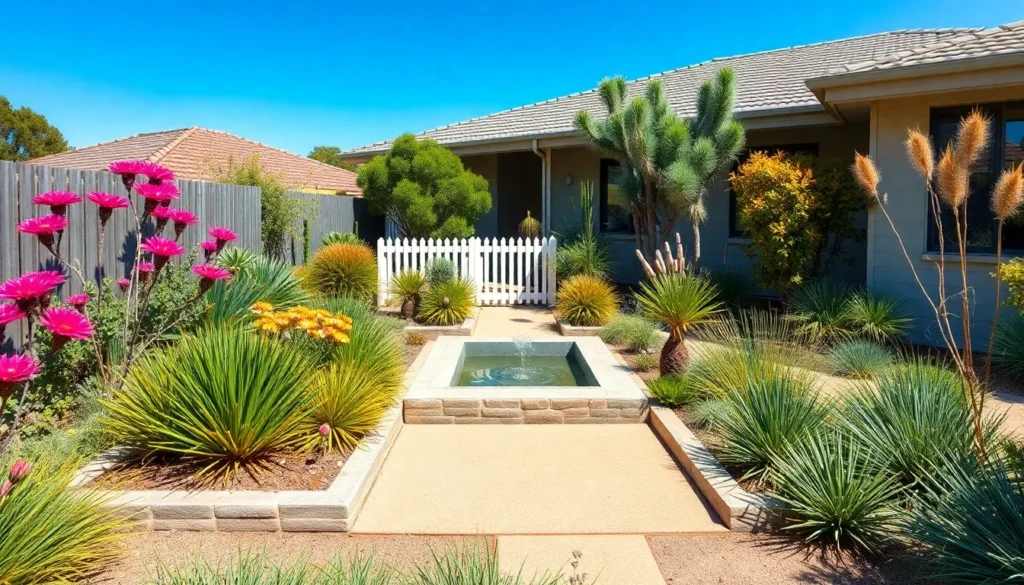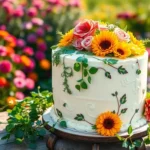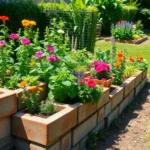We’ve all walked past those stunning Australian front gardens that make us stop and stare. Whether it’s the perfect blend of native plants thriving in harsh conditions or the clever use of drought-resistant landscaping that somehow looks effortlessly beautiful, these outdoor spaces showcase what’s possible when design meets practicality.
Creating an impressive front garden in Australia isn’t just about curb appeal – it’s about working with our unique climate challenges while crafting a space that welcomes visitors and reflects your personal style. From Melbourne’s unpredictable weather to Perth’s dry summers, we understand that successful Australian gardens need to be both gorgeous and resilient.
We’re here to share the most effective front garden ideas that actually work in Australian conditions. You’ll discover low-maintenance plants that flourish year-round, design principles that maximize visual impact, and practical answers that won’t break your budget or require constant upkeep.
Native Australian Plants for Low-Maintenance Front Gardens
Australian natives thrive in our challenging climate conditions without demanding constant attention. These resilient plants create stunning front gardens that reflect our unique industry while requiring minimal water and maintenance.
Drought-Tolerant Eucalyptus Varieties
River Red Gum (Eucalyptus camaldulensis) stands as one of our most adaptable eucalyptus species for front gardens. This magnificent tree tolerates extreme drought conditions and provides excellent shade coverage for smaller plants beneath its canopy. We recommend planting it as a feature tree in larger front yards where its 15-20 meter height won’t overwhelm the space.
Lemon Scented Gum (Corymbia citriodora) offers beautiful white bark and aromatic leaves that release a fresh citrus fragrance when crushed. This variety grows to approximately 25-35 meters but responds well to regular pruning to maintain a manageable size for residential gardens. Its smooth trunk creates striking visual interest year round.
Silver Dollar Tree (Eucalyptus cinerea) produces distinctive round blue-gray leaves that florists prize for arrangements. We particularly appreciate this compact variety because it reaches only 6-10 meters in height and width. Its silvery foliage creates beautiful contrast against darker native plants like banksias and grevilleas.
Colorful Banksia Species
Banksia spinulosa delivers vibrant orange-yellow bottle brush flowers from autumn through winter. This hardy shrub reaches 2-3 meters tall and spreads 1.5-2 meters wide, making it perfect for medium-sized front garden spaces. We’ve observed it thriving in both coastal and inland Australian conditions with minimal supplemental watering.
Banksia ericifolia showcases spectacular orange cylindrical flower spikes that attract native birds and insects. This species grows 3-6 meters tall and adapts well to poor sandy soils that challenge many other plants. Its needle-like leaves provide fine textural contrast against broad-leafed companions.
Banksia integrifolia produces creamy yellow flowers and tolerates salt spray, making it ideal for coastal front gardens. We recommend this species for gardeners seeking year-round structure because its dense foliage maintains attractive form even when not flowering. This banksia reaches 5-15 meters depending on growing conditions.
Ground-Covering Grevilleas
Grevillea ‘Robyn Gordon’ creates dense spreading mats covered in red and yellow spider-like flowers throughout most of the year. This popular cultivar grows 50 centimeters tall and spreads 2 meters wide, making it excellent for filling large areas between taller plants. We’ve found it particularly effective for suppressing weeds naturally.
Grevillea lanigera forms low cushions of soft gray-green foliage topped with clusters of cream, pink, or red flowers. This compact species reaches only 30-60 centimeters tall but spreads 1-2 meters wide, creating beautiful carpets of color. Its woolly leaves add interesting texture to front garden compositions.
Grevillea thelemanniana produces masses of small red flowers against fine green foliage from winter through spring. We appreciate this species because it tolerates light foot traffic and works well as a living mulch around feature plants. This grevillea grows 30-100 centimeters tall depending on the exact form selected.
Modern Minimalist Front Garden Designs
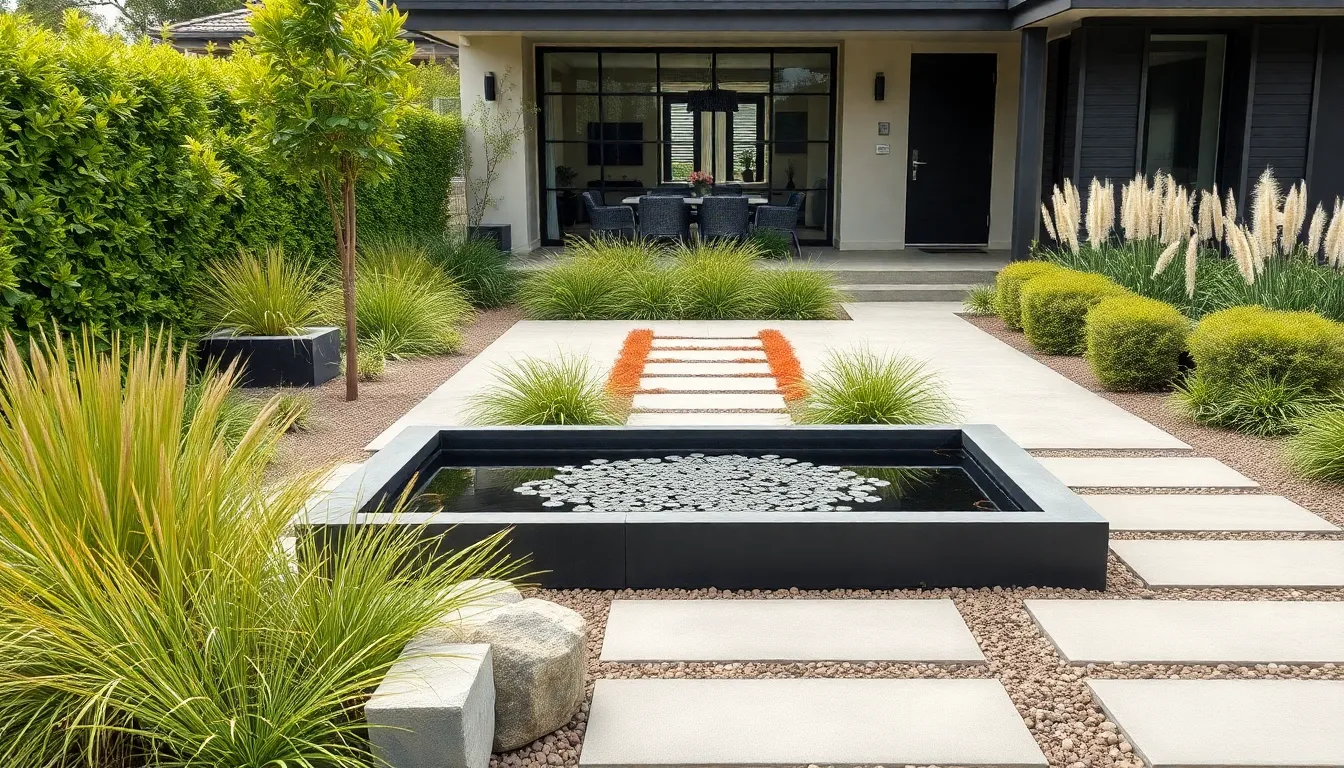
Australian homeowners increasingly embrace simplicity in their outdoor spaces, creating sophisticated entrances that complement contemporary architecture. These designs prioritize clean aesthetics while maintaining practical functionality for our unique climate conditions.
Clean Lines with Ornamental Grasses
Ornamental grasses create the foundation of modern minimalist front gardens across Australia. We recommend these versatile plants because they add texture and movement without overwhelming the space’s clean aesthetic. Feather reed grass and fountain grass varieties thrive in most Australian climates while requiring minimal water once established.
Strategic placement of ornamental grasses along property borders creates natural screening that moves gracefully in our coastal breezes. Native varieties like lomandra and dianella integrate seamlessly with existing landscapes while providing year round visual interest. Their vertical growth patterns complement horizontal architectural elements perfectly.
Grouping different grass heights creates depth without cluttering the design. Taller varieties like miscanthus work beautifully as backdrop plants, while shorter grasses fill gaps between hardscape elements and create smooth transitions throughout the garden space.
Geometric Planting Beds
Geometric planting beds bring structure and sophistication to Australian front gardens. We design these beds using clean rectangular or circular shapes that echo the home’s architectural lines and create visual harmony between indoor and outdoor spaces.
Raised geometric beds offer excellent drainage in areas with heavy clay soils common throughout Melbourne and Sydney suburbs. Concrete or steel edging materials define these spaces while allowing for precise plant placement that maintains the design’s integrity over time.
Plant selection within geometric beds focuses on species with consistent growth habits and complementary foliage colors. Buxus hedging creates perfect borders for these structured spaces, while westringia provides excellent topiary potential for homeowners seeking sophisticated focal points.
Contemporary Water Features
Contemporary water features serve as stunning centerpieces in minimalist Australian front gardens. We incorporate small ponds or minimalist fountains that enhance visual appeal while creating peaceful sounds that mask street noise effectively.
Rectangular concrete water basins integrate seamlessly with modern architecture while requiring minimal maintenance compared to traditional pond designs. These features work particularly well in courtyards and smaller front garden spaces where every element must serve multiple purposes.
Solar powered fountain systems reduce ongoing energy costs while providing the soothing water sounds that make front entrances more welcoming. Positioning these features near seating areas or along main walkways maximizes their impact on both residents and visitors approaching the home.
Traditional Cottage Garden Styles Adapted for Australian Climate
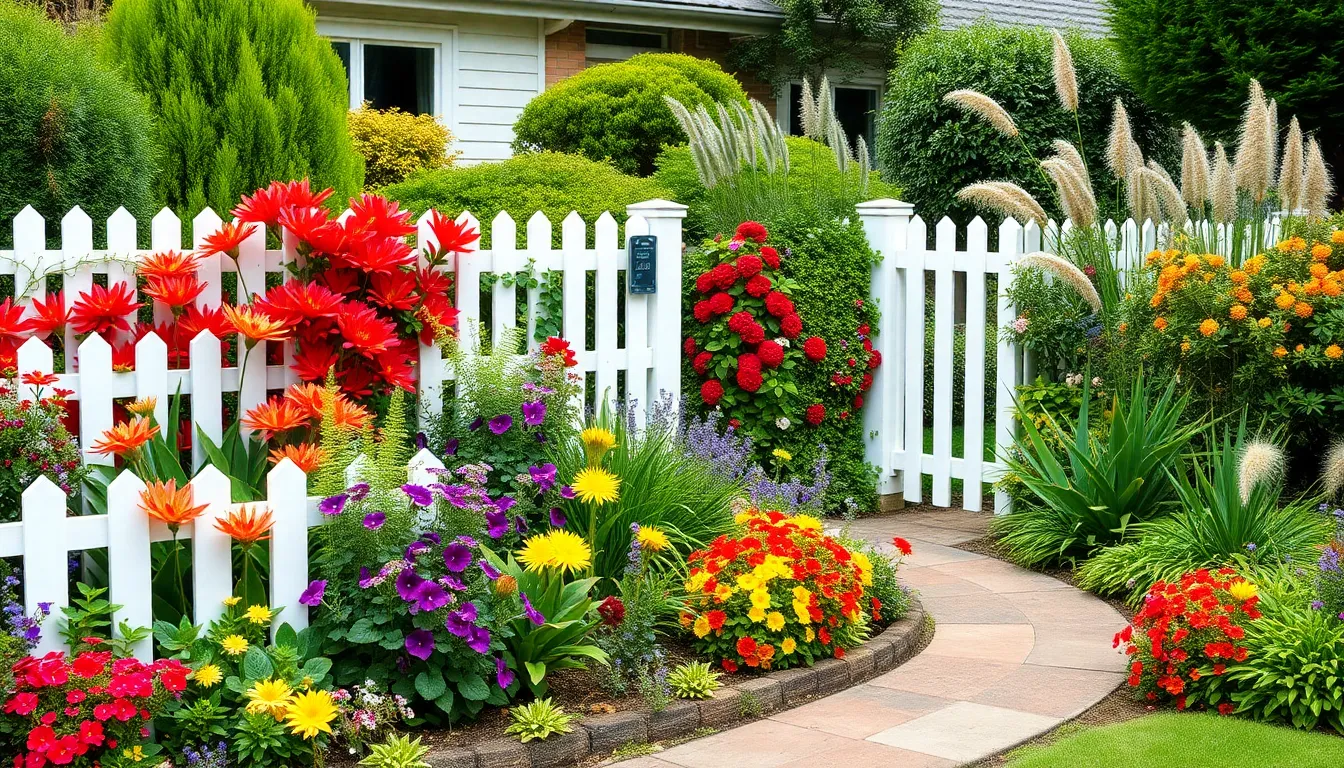
Moving from sleek minimalist designs, we’ll explore the timeless charm of cottage gardens reimagined for Australia’s unique climate. These romantic garden styles blend traditional English cottage aesthetics with drought resistant natives and heat tolerant plants.
Heat-Resistant Perennial Borders
Kangaroo paw transforms perennial borders with its distinctive fuzzy flowers that thrive in scorching Australian summers. Native violets provide delicate purple blooms throughout spring while requiring minimal water once established. Daisies create cheerful white and yellow displays that continue flowering even during extended dry periods.
Combining these heat resistant perennials with evergreen shrubs ensures our borders maintain structure year round. Lavender adds Mediterranean charm while releasing fragrant oils that intensify in hot weather. Silver leafed plants like dusty miller create cooling visual contrasts against the vibrant blooms of native species.
Picket Fence Plantings
Ornamental grasses soften harsh fence lines while requiring almost no maintenance in Australian conditions. Clipped buxus plants create formal hedging that stays green through drought and heat waves. These structured plantings provide the perfect backdrop for cottage garden favorites.
Flowering vines climb picket fences to create vertical interest and seasonal color changes. Native climbing plants like hardenbergia produce masses of purple flowers in spring. Positioning these plantings strategically creates welcoming entrances that frame our front garden views beautifully.
Seasonal Color Combinations
Silver foliage plants anchor cottage garden color schemes throughout Australia’s variable seasons. Deep green natives provide consistent structure while burnt orange marigolds and calendulas add warm autumn tones. Soft mauve flowers from native shrubs create romantic color transitions.
Mixing these established color palettes ensures our cottage gardens remain vibrant when temperatures soar. Native violets emerge in spring with delicate purple blooms that complement silver artemisia foliage. Summer brings kangaroo paw flowers in reds and yellows that pair beautifully with deep green backdrop plants.
Xerophytic Garden Ideas for Water-Wise Landscaping
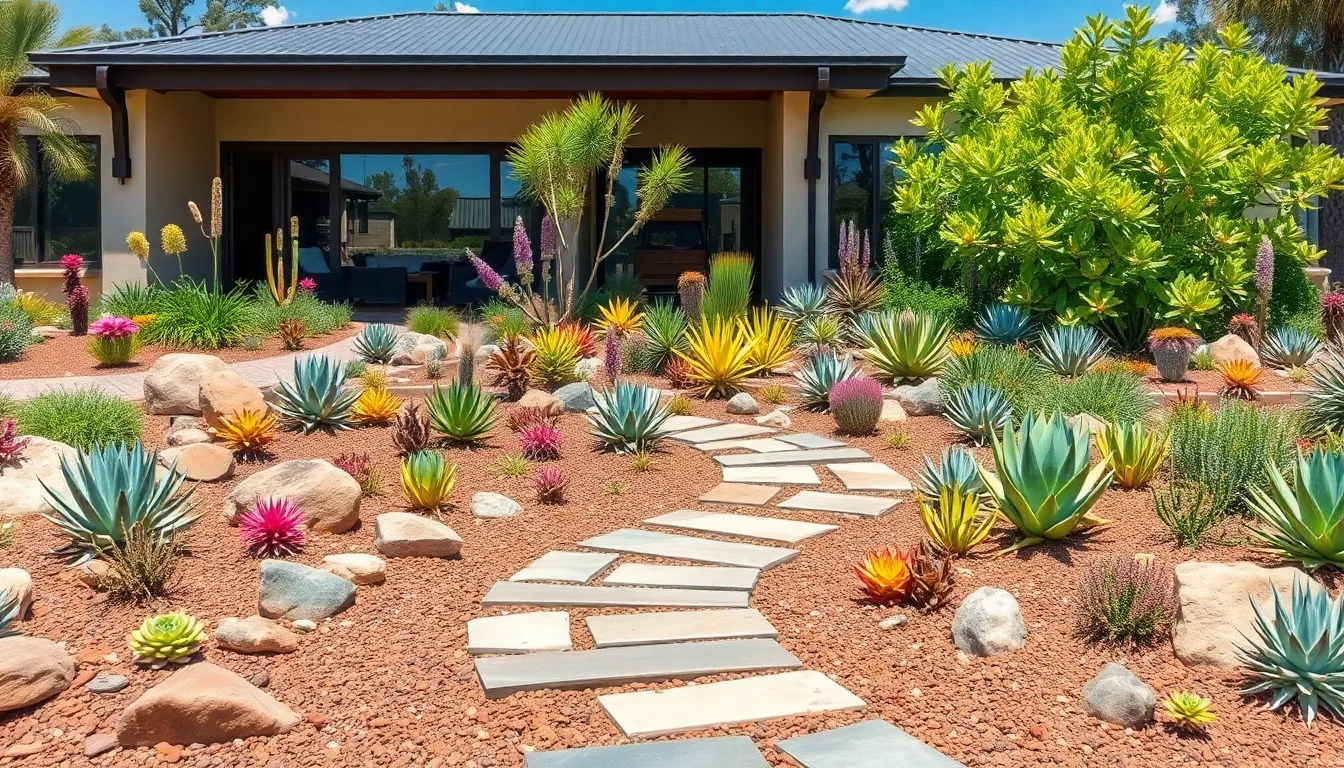
Transitioning from cottage charm to practical sustainability, xerophytic gardens represent the ultimate solution for Australian homeowners seeking beautiful landscapes with minimal water requirements. These drought-tolerant designs perfectly complement Australia’s varied climate conditions while reducing maintenance needs and supporting water conservation efforts.
Succulent Display Gardens
Succulent arrangements create stunning focal points that thrive in Australia’s hot, dry regions with minimal irrigation needs. Echeverias form rosette patterns that catch morning light beautifully, while sedums spread naturally to fill gaps between larger specimens. Agaves provide dramatic architectural elements that anchor succulent displays, and cacti add sculptural interest with their unique forms and occasional blooms.
Creating cohesive displays requires careful attention to texture and color combinations throughout your garden beds. Quartzite pebbles provide excellent drainage while reflecting heat away from plant roots, and stepping stones guide visitors through your succulent garden without disturbing delicate specimens. Groupings of similar species create visual impact, while varied heights add dimensional interest to flat landscapes.
Maintenance becomes effortless when you select appropriate succulent varieties for your local climate conditions. Watering requirements drop significantly compared to traditional gardens, typically needing attention only during extended dry periods. Sculptural elements like weathered timber or metal accents complement succulent forms while adding contemporary appeal to your front garden design.
Rock Garden Arrangements
Rock gardens combine natural stone elements with hardy plants to create texture-rich landscapes that handle Australia’s challenging weather conditions. Decorative rocks in varied sizes create visual hierarchy while providing excellent drainage for drought-tolerant plantings. Selecting rocks with different shapes and colors adds natural appeal, while larger specimens serve as anchor points for your overall design.
Planting strategies focus on low-growing species that thrive in rocky conditions with minimal soil depth. Native ground covers spread naturally between rock crevices, creating soft contrast against hard stone surfaces. Positioning plants requires careful consideration of mature size, ensuring adequate space for growth without overcrowding your rock arrangements.
Practical benefits extend beyond aesthetics when you incorporate rock gardens into sloping or compact front yard spaces. Maintenance requirements decrease significantly as rocks suppress weed growth naturally, reducing ongoing garden care needs. Installation costs remain reasonable since many suitable rocks are locally available, and established rock gardens provide years of low-maintenance beauty.
Mulch and Stone Pathways
Mulch pathways offer functional beauty while supporting sustainable water management throughout your xerophytic garden design. Gravel surfaces provide excellent permeability, allowing rainwater to infiltrate soil naturally rather than creating problematic runoff. Crushed stone options come in various colors and textures, enabling you to match pathway materials with your overall garden aesthetic.
| Pathway Material | Water Permeability | Maintenance Level | Cost Range |
|---|---|---|---|
| Gravel | High | Low | Budget-friendly |
| Crushed Stone | High | Low | Moderate |
| Recycled Mulch | Medium | Medium | Budget-friendly |
| Decorative Pebbles | High | Low | Higher |
Design functionality improves when pathways guide visitors naturally through your front garden while protecting established plantings. Stone barriers prevent soil erosion during heavy rainfall events, maintaining garden structure throughout seasonal weather changes. Pathway edges defined with larger stones or steel edging create clean lines that complement both formal and informal garden styles.
Installation techniques determine long-term pathway performance and appearance in your water-wise industry. Proper base preparation ensures pathway stability, while appropriate depth prevents stone migration during maintenance activities. Regular top-up applications maintain pathway appearance, though frequency depends on chosen materials and local weather conditions affecting your exact garden location.
Tropical-Inspired Front Gardens for Northern Australia
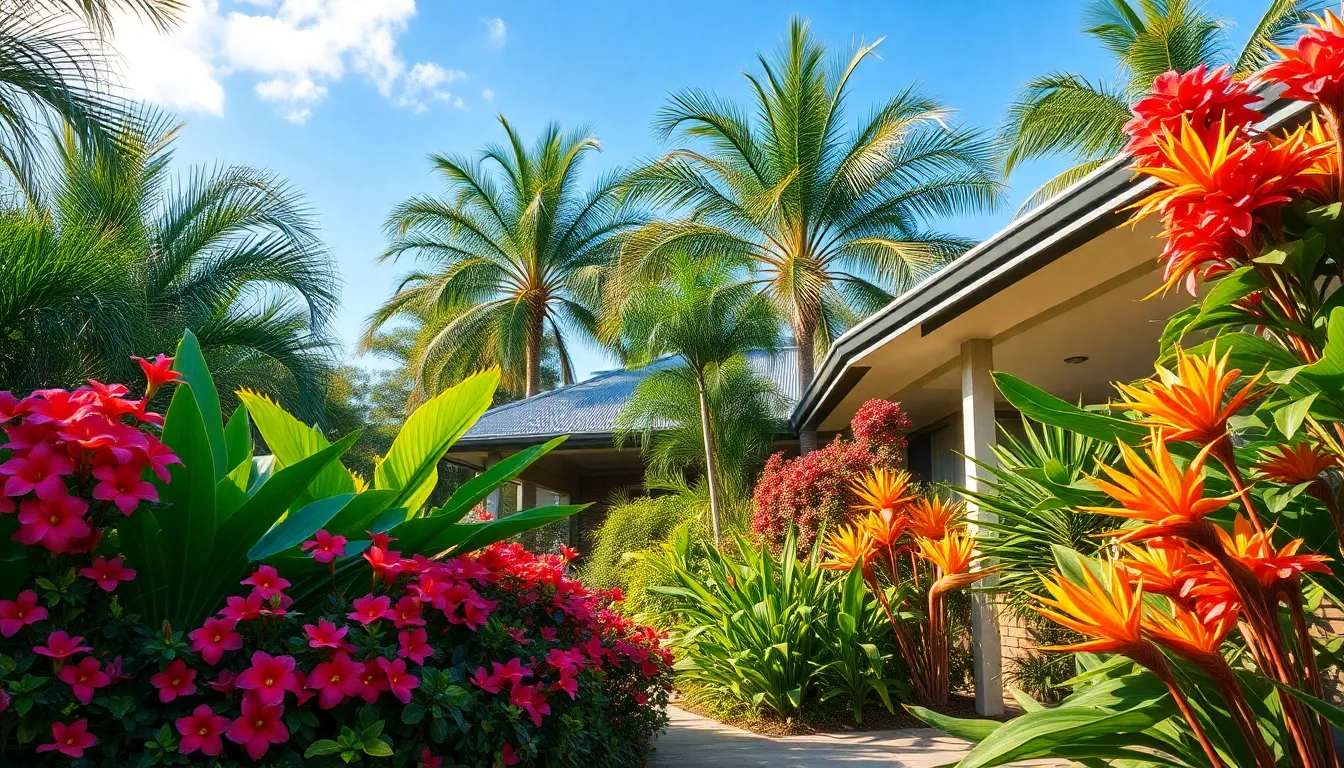
Northern Australia’s warm climate creates perfect conditions for lush tropical front gardens that feel like private oases. These designs blend vibrant foliage with dramatic architectural plants to create stunning curb appeal.
Palm Tree Focal Points
Foxtail palms serve as exceptional centerpieces for tropical front gardens, offering height and dramatic visual impact. We recommend positioning these statement trees at key viewing angles from the street to maximize their architectural effect.
Strategic placement creates multiple layers of visual interest throughout your garden space. Consider planting foxtail palms near entryways or corner positions where their distinctive fronds can catch natural light.
Grouping different palm varieties adds texture variation while maintaining the tropical theme. Mix foxtail palms with golden cane palms or bangalow palms to create depth and movement in your industry design.
Lush Foliage Plants
Bird of paradise plants deliver instant tropical atmosphere with their large paddle shaped leaves and exotic orange blooms. These showstoppers thrive in Northern Australia’s humidity and create natural privacy screens.
Bromeliads provide colorful ground level interest with their rosette formations and bright central flowers. We suggest planting varieties like Aechmea and Guzmania in clusters beneath taller palms for layered tropical appeal.
Dense foliage combinations work best when you mix different leaf shapes and sizes throughout your planting beds. Combine broad leafed plants with spiky varieties to create visual contrast and maintain year round green coverage.
Colorful Flowering Shrubs
Hibiscus shrubs offer continuous blooms in vibrant reds, yellows, and pinks that attract butterflies and hummingbirds to your front garden. These hardy performers handle Northern Australia’s heat while providing months of colorful displays.
Heliconia plants create bold tropical statements with their bright orange and red bird like flowers that emerge from thick green stems. Position these eye catching shrubs where their dramatic blooms can be appreciated from multiple viewing points.
Layered flowering arrangements maximize visual impact when you combine different bloom times and heights throughout your garden beds. Mix early flowering hibiscus with later blooming heliconia to ensure continuous color from spring through autumn.
Coastal Front Garden Solutions
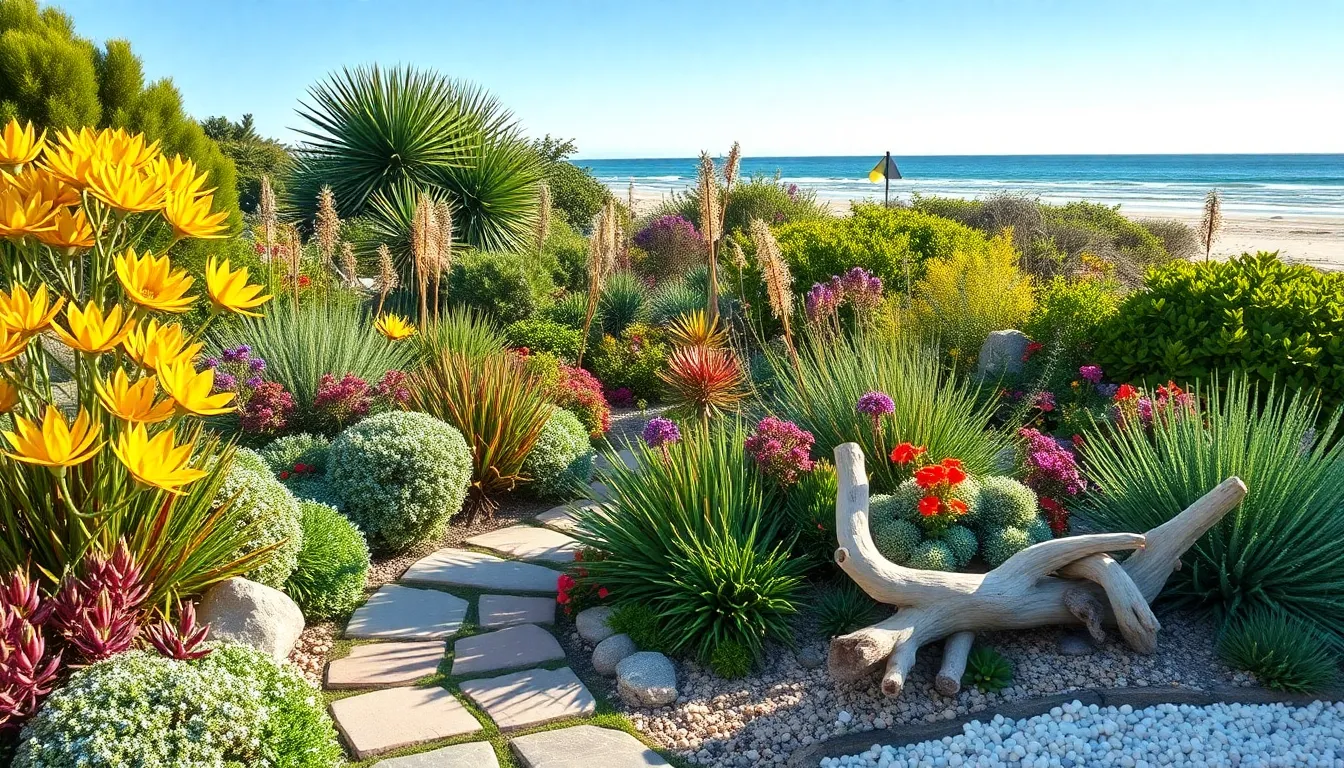
Australia’s coastal regions present unique challenges that require specialized gardening approaches to create thriving front yards. We’ll explore proven strategies for building beautiful gardens that withstand salt spray, strong winds, and harsh seaside conditions.
Salt-Tolerant Plant Selections
Banksia species form the backbone of successful coastal gardens, offering exceptional salt tolerance while providing stunning visual impact. We recommend incorporating grevillea varieties that naturally adapt to salt exposure and deliver colorful blooms throughout the year. Kangaroo paw brings distinctive Australian character to coastal plantings while thriving in salty conditions that challenge other perennials.
Acacia trees create excellent screening and windbreaks for coastal properties, establishing quickly in sandy soils common to beachside locations. Carpobrotus rossii serves dual purposes as ground cover and erosion control, producing beautiful white blooms that complement the coastal aesthetic.
| Plant Type | Salt Tolerance | Bloom Period | Maintenance Level |
|---|---|---|---|
| Banksia | High | Year-round | Low |
| Grevillea | High | Spring-Fall | Low |
| Kangaroo Paw | High | Spring-Summer | Medium |
| Acacia | High | Winter-Spring | Low |
| Carpobrotus rossii | Very High | Spring-Summer | Very Low |
Wind-Resistant Landscaping
Native plantings provide the strongest foundation for wind resistance, having evolved specifically to handle Australia’s coastal conditions. We design curved pathways that follow natural contours, reducing wind tunneling effects while creating more attractive garden flow.
Dense planting strategies using large trees and shrubs establish protective barriers that shield more delicate plants from prevailing winds. Grouping plants in clusters rather than spacing them individually creates microclimates that reduce wind stress on individual specimens.
Layered plantings work effectively when we position tall windbreak plants along property edges, medium shrubs in middle zones, and ground covers in protected inner areas. This graduated approach allows each plant layer to protect the next while maintaining visual interest throughout the garden.
Beach-Themed Design Elements
Water features enhance coastal gardens through small fountains or sculptural elements that echo the nearby ocean’s movement and sound. We position these features strategically to create focal points while providing soothing background noise.
Mediterranean stone pathways add exotic appeal to coastal designs, using natural materials that complement the beachside environment while providing durable walking surfaces. These pathways weather salt exposure better than concrete alternatives while maintaining their attractive appearance.
Decorative elements like carefully placed driftwood or shell accents reinforce the coastal theme without overwhelming the natural plantings. Outdoor showers surrounded by tropical plantings create luxurious privacy zones that feel like natural extensions of the beach environment.
Natural material combinations work best when we select stones, timber, and metals that age gracefully in salt air, developing attractive patinas that enhance rather than detract from the overall design.
Small Space Front Garden Maximization
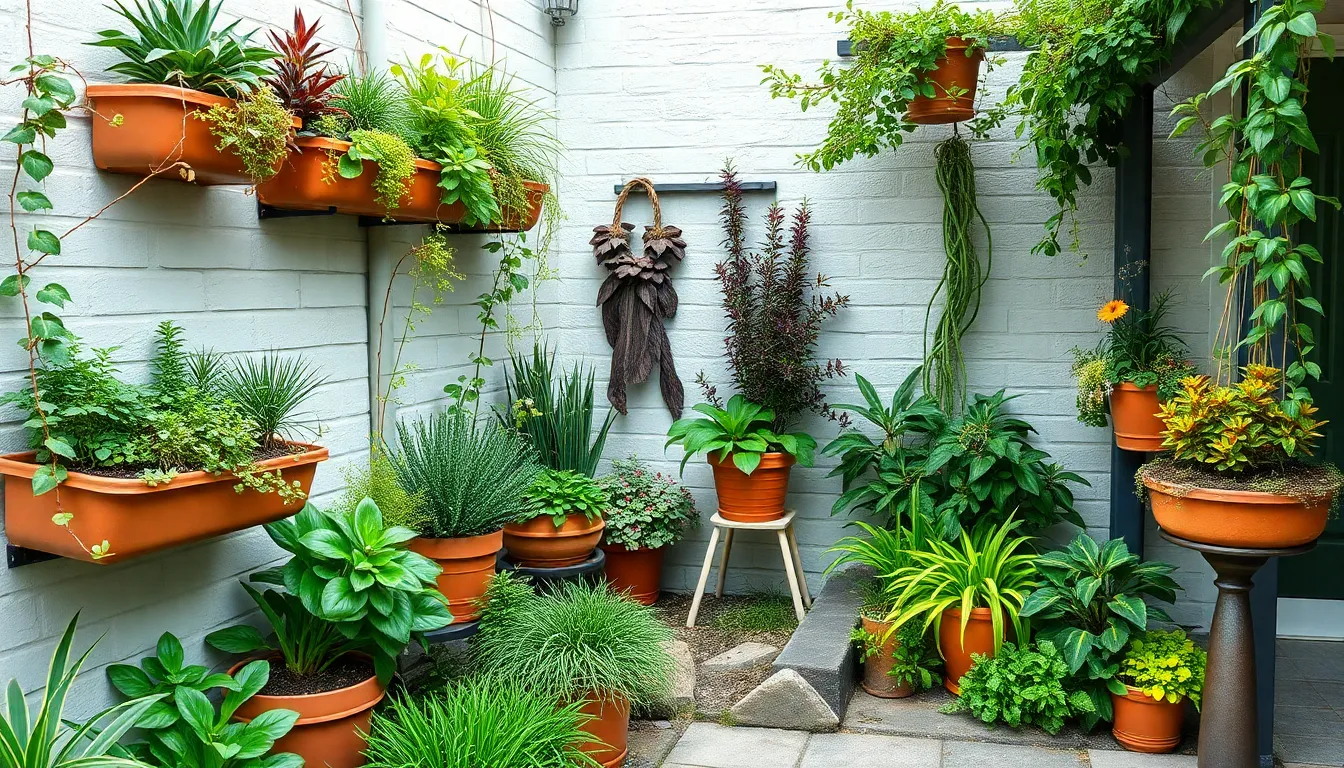
Transforming compact front yards into stunning garden showcases requires strategic planning and creative answers. We’ll explore proven techniques that maximize every square meter while maintaining visual appeal and functionality.
Vertical Gardening Techniques
Wall mounted planters create instant growing space without consuming precious ground area in small Australian front gardens. We recommend installing these planters at varying heights to establish visual interest while accommodating herbs, flowers, or hardy succulents that thrive in our climate conditions.
Trellises transform bare walls into living art by supporting climbing plants like star jasmine or native ivy species. Training these plants upward maximizes your planting area while creating natural privacy screens that soften harsh architectural lines. Position trellises strategically to frame entrances or hide unsightly utility areas.
Green walls offer the ultimate space saving solution by converting entire vertical surfaces into planted areas. These systems work particularly well with native Australian plants that handle varying moisture levels and provide year round coverage without extensive maintenance requirements.
Container Garden Arrangements
Mixed plantings combine flowers, herbs, and small shrubs within single containers to create diverse visual displays. We suggest pairing drought tolerant natives like kangaroo paw with aromatic herbs such as rosemary or lavender for containers that deliver both beauty and functionality.
Themed containers focus on exact plant categories to create cohesive design statements throughout your front garden space. Succulent themed arrangements work exceptionally well in Australian conditions, featuring echeverias, sedums, and small agaves that require minimal watering while providing striking architectural forms.
Mobility advantages allow container gardens to adapt to seasonal changes and evolving design preferences. Moving containers to optimize sun exposure or create new focal points gives small front gardens incredible flexibility that traditional planted beds cannot match.
Multi-Level Planting Strategies
Tiered planters establish multiple growing levels within confined spaces by stacking containers or using purpose built stepped systems. These arrangements work perfectly for displaying collections of native plants while ensuring each specimen receives adequate light and air circulation.
Raised beds add dimensional depth to flat front garden areas while improving drainage conditions that many Australian native plants require. Incorporating raised beds at varying heights creates natural boundaries and planting zones that guide visitors through your compact garden space.
Cascading arrangements use height differences to create waterfall effects with trailing plants like native violets or creeping grevilleas. These plantings soften hard edges of pathways and structures while maximizing visual impact in areas where ground space remains limited.
Wildlife-Friendly Front Garden Designs
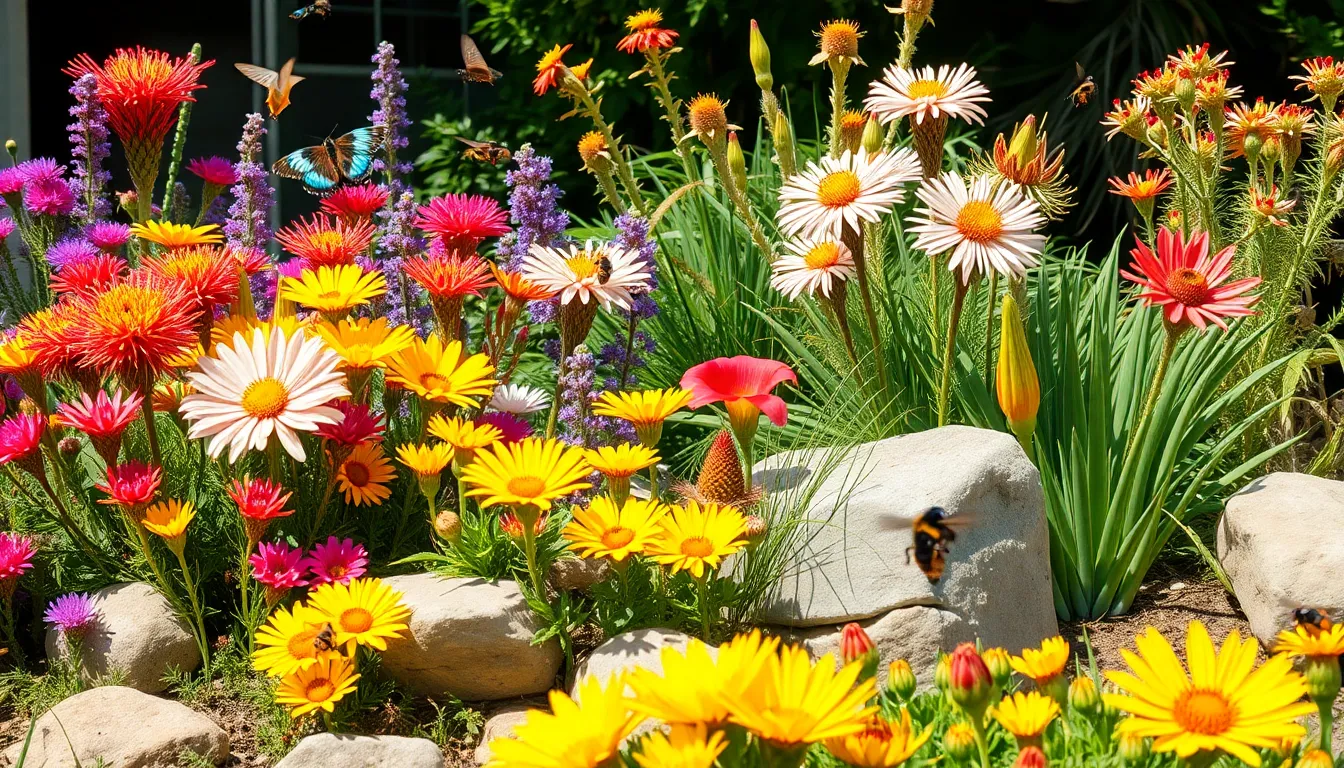
Creating a wildlife-friendly front garden transforms your outdoor space into a thriving network that supports local biodiversity while maintaining stunning curb appeal. We’ll show you how to design gardens that provide essential habitats for native animals through strategic plant selection and thoughtful industry features.
Native Bird-Attracting Plants
Grevilleas stand out as exceptional choices for attracting honeyeaters with their abundant nectar production. We recommend planting multiple varieties to ensure continuous blooming throughout different seasons. Banksias create magnificent focal points while simultaneously attracting both nectar-feeding and seed-eating bird species to your garden.
Eucalypts support diverse insect populations that become vital food sources for insectivorous birds. We suggest selecting smaller eucalyptus varieties for front gardens to maintain appropriate scale while maximizing ecological benefits. Layering these plants at different heights creates natural feeding zones that accommodate various bird species’ preferences.
Timing becomes crucial when selecting bird-attracting plants that flower at different periods throughout the year. We’ve found that combining early spring bloomers like certain grevillea species with winter-flowering banksias ensures year-round food supply for resident and migratory birds.
Butterfly Garden Sections
Brachyscome daisies provide essential nectar sources while adding cheerful color to butterfly garden areas. We position these plants in sunny, sheltered locations where butterflies can easily access their open flower structures. Leptospermum species offer both nectar for adult butterflies and habitat complexity that supports their lifecycle needs.
Native violets serve dual purposes as both nectar sources and host plants for certain butterfly larvae. We create varying plant heights within butterfly sections to accommodate different species’ feeding and breeding requirements. Milkweeds, though not native, have become widely accepted additions that support monarch butterfly populations specifically.
Shelter elements enhance butterfly garden effectiveness by providing wind protection and basking sites. We incorporate natural materials like strategically placed rocks and logs that create warm microclimates where butterflies can regulate their body temperature throughout the day.
Bee-Friendly Flowering Plants
Kangaroo Paw delivers abundant nectar and pollen through its unique tubular flowers that bees can easily access. We plant these in groups of three or more to create substantial foraging areas that attract and sustain bee populations. Their distinctive orange, red, and yellow blooms add vibrant color while serving essential ecological functions.
Westringia varieties provide continuous flowering throughout most of the year, ensuring consistent bee resources. We’ve observed that these coastal rosemary plants thrive in various soil conditions while requiring minimal maintenance once established. Their small white or purple flowers cluster densely, creating efficient feeding stations for different bee species.
Melaleuca species offer exceptional value for bee gardens through their bottlebrush-style flowers packed with accessible nectar. We avoid using pesticides in bee-friendly sections and maintain some bare ground areas where ground-nesting bee species can establish their colonies. Seasonal diversity becomes essential, so we select plants that bloom during spring, summer, and autumn to support bee populations throughout their active periods.
Year-Round Color Schemes for Australian Front Gardens
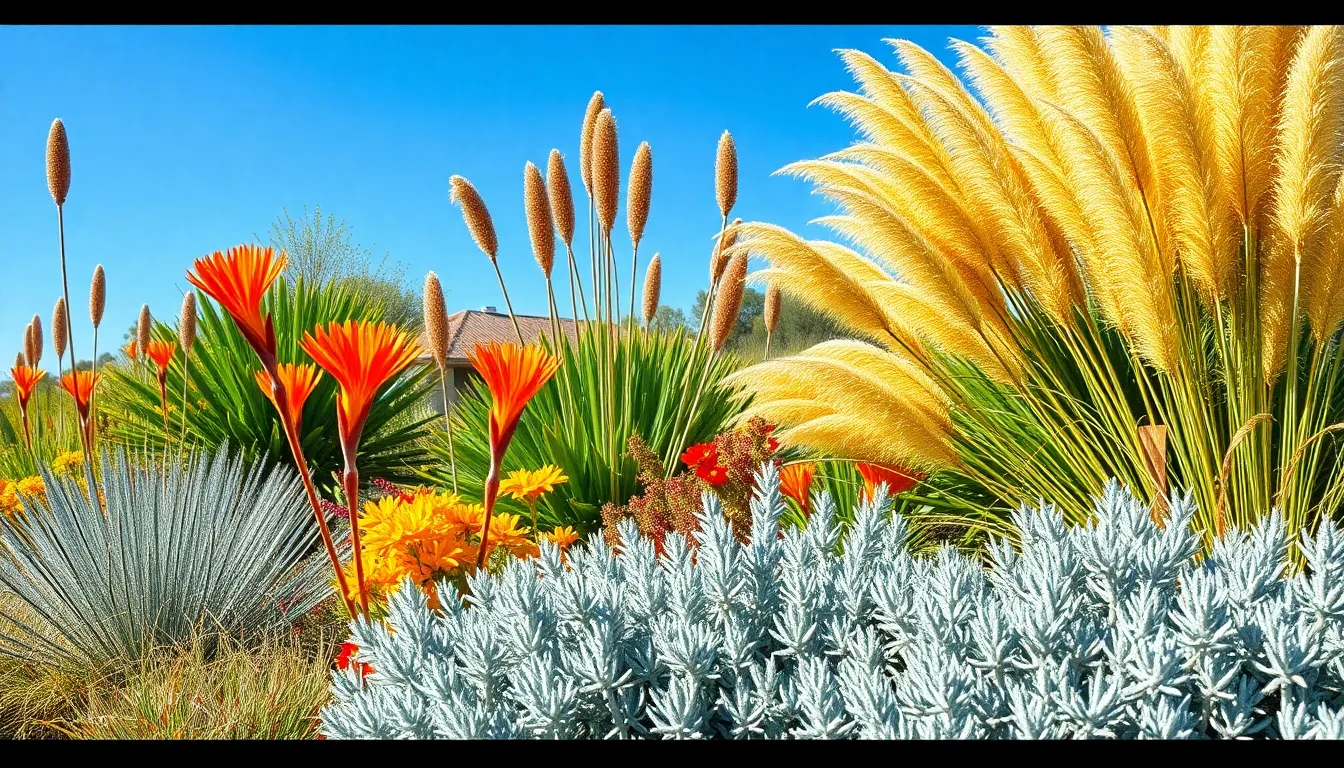
We’ll show you how to maintain vibrant colors throughout every season using strategic plant combinations. Creating continuous color displays requires combining evergreen plants with seasonal flowers like kangaroo paw, daisies, and native violets while incorporating silver foliage, deep greens, and bursts of burnt orange or soft mauve for dimensional style.
Spring Flowering Combinations
Spring flowering displays transform your front garden with fresh bursts of color after winter’s dormancy. Daffodils and tulips create vibrant displays when planted alongside established native shrubs that provide structural support. Early blooming kangaroo paw varieties emerge in late winter and continue through spring, offering striking orange and red spikes that complement traditional spring bulbs.
Native violets spread naturally beneath taller plants, creating purple carpets that bridge the gap between formal spring plantings and year round natives. We recommend combining these ground covers with silver foliage plants like dusty miller to create contrast and visual depth. Ornamental grasses begin their fresh growth during spring, providing texture and movement that enhances the overall garden composition.
Summer Heat-Resistant Displays
Summer heat resistant displays focus on drought tolerant plants that thrive during Australia’s intense summer months. Succulents and cacti create stunning geometric patterns while requiring minimal water, making them perfect for harsh summer conditions. These plants store water in their leaves and stems, allowing them to maintain their appearance even during extended dry periods.
Kangaroo paw varieties excel during summer heat, producing their distinctive flowers continuously throughout the season. Grevilleas provide both colorful blooms and evergreen structure, with many species flowering most prolifically during the warmer months. We suggest grouping these native plants with ornamental grasses that turn golden during summer, creating warm color palettes that celebrate the season rather than fighting against it.
Winter Interest Plants
Winter interest plants ensure your front garden maintains color and structure during the cooler months. Cyclamen and violas provide cheerful blooms when most other plants are dormant, offering purple, pink, and white flowers that brighten winter landscapes. These cool season annuals thrive in the milder temperatures and can handle light frosts that occur in many Australian regions.
Evergreen shrubs become the backbone of winter gardens, with their foliage providing consistent color and form. Mature trees like frangipani maintain their sculptural branches even when leafless, creating dramatic silhouettes that serve as living sculptures. We recommend incorporating winter flowering natives like certain banksia species that bloom during the cooler months, ensuring continuous nectar sources for wildlife while maintaining garden interest.
Budget-Friendly Front Garden Transformations
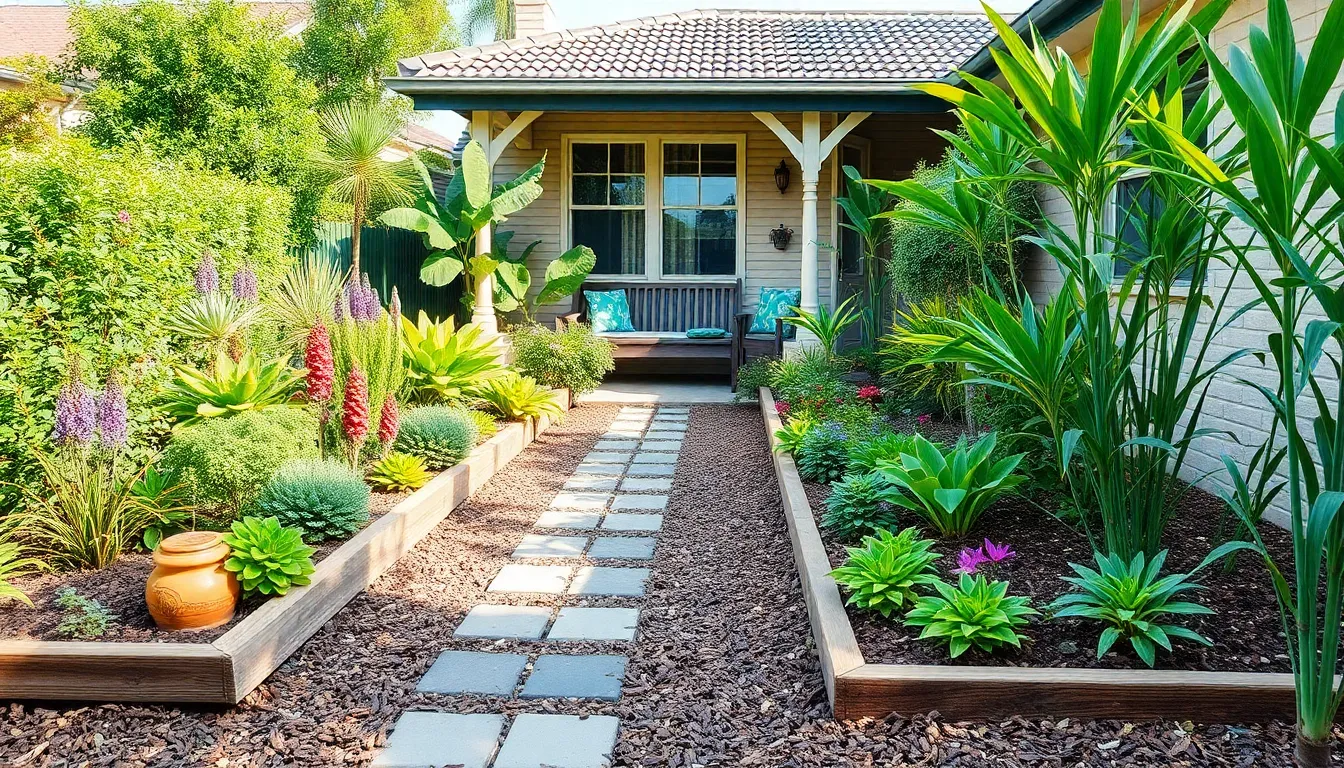
Creating a stunning front garden doesn’t require a hefty budget. We’ll show you proven strategies that maximize curb appeal while keeping costs minimal through smart planning and resourceful approaches.
DIY Landscaping Projects
Garden edging with recycled timber creates defined borders without expensive materials. Installing these borders yourself saves labor costs and gives you complete control over the design aesthetic.
Mulch installation transforms bare soil areas into polished garden beds for under $50 per cubic meter. Spreading organic mulch around plants reduces water requirements and suppresses weeds naturally.
Small retaining walls using inexpensive blocks solve drainage issues and create visual interest. Building these structures with concrete blocks or natural stones costs significantly less than hiring professionals.
Defined zones with reclaimed bricks establish clear pathways and planting areas. Creating these borders using salvaged pavers or secondhand bricks adds character while staying within tight budgets.
Outdoor seating areas from leftover materials provide functional gathering spaces. Constructing simple benches or fire pits using construction remnants or garage sale finds adds value without major expense.
Propagation and Plant Swapping
Asking friends for plant cuttings ensures species already thrive in local conditions. These established varieties have proven survival rates in your exact climate and soil conditions.
Organizing community plant swaps provides access to diverse species at no cost. Participating in these events creates neighborhood connections while expanding your garden variety significantly.
Growing plants from seeds multiplies your investment exponentially. Starting annuals and vegetables from seed packets costs cents per plant compared to nursery prices.
Dividing established perennials creates multiple plants from single specimens. Splitting ornamental grasses and flowering plants during dormant seasons generates new garden areas without purchasing additional stock.
Repurposed Material Ideas
Old pallets transformed into garden beds use discarded shipping materials effectively. Converting these wooden structures into raised planters costs only fasteners and basic tools.
Leftover bricks forming pathways create attractive walkways from construction waste. Arranging these materials in patterns adds visual appeal while solving drainage and access issues.
Discarded containers serving as planters offer unique growing answers. Repurposing old buckets, tires, or metal containers creates distinctive focal points throughout your garden space.
Salvaged timber for decorative edging defines planting areas with architectural interest. Using reclaimed wood from renovation projects or construction sites reduces material costs dramatically.
Flea market finds adding personality introduce character without important investment. Incorporating vintage ornaments, furniture pieces, or decorative elements from secondhand sources creates distinctive garden themes.
Conclusion
We’ve explored countless ways to transform your front garden into a stunning Australian oasis that thrives year-round. From drought-resistant natives to tropical paradises and coastal sanctuaries there’s a perfect style waiting for every home and climate zone.
The key to success lies in choosing plants and designs that work with Australia’s unique conditions rather than against them. Whether you’re working with a sprawling space or a compact courtyard the right combination of native species smart design and creative answers will deliver remarkable results.
Your front garden doesn’t need to expensive to make a lasting impression. With thoughtful planning sustainable choices and a focus on wildlife-friendly features you’ll create an entrance that’s both beautiful and beneficial to our local environment.
Start small experiment with different elements and watch as your front garden becomes the neighborhood’s most admired feature.
Frequently Asked Questions
What are the best native Australian plants for low-maintenance front gardens?
Eucalyptus varieties like River Red Gum and Lemon Scented Gum are excellent choices, offering drought tolerance and unique aesthetics. Colorful banksia species such as Banksia spinulosa and Banksia ericifolia provide vibrant blooms while attracting wildlife. Ground-covering grevilleas like ‘Robyn Gordon’ create beautiful landscapes with minimal upkeep while suppressing weeds effectively.
How can I create a modern minimalist front garden in Australia?
Focus on clean lines with ornamental grasses like feather reed grass for texture without overwhelming the design. Use geometric planting beds with raised structures for better drainage. Incorporate contemporary water features such as minimalist fountains or rectangular concrete basins as stunning centerpieces that complement modern architecture.
What plants work best for cottage-style gardens in Australia’s climate?
Heat-resistant perennials like kangaroo paw, native violets, and cheerful daisies thrive in Australian summers. Combine these with evergreen shrubs such as lavender and dusty miller for year-round structure. Add picket fence plantings with ornamental grasses and flowering vines to soften harsh lines and provide seasonal color changes.
How do I design a water-wise xerophytic garden?
Choose drought-tolerant succulents like Echeverias, sedums, and agaves that require minimal irrigation. Create rock garden arrangements combining natural stone with hardy plants for texture-rich landscapes. Use mulch and stone pathways to enhance water management while guiding visitors through your drought-resistant garden design.
What tropical plants work for Northern Australian front gardens?
Foxtail palms make dramatic focal points with strategic placement for maximum visual impact. Include lush foliage plants like bird of paradise and bromeliads for tropical atmosphere and natural privacy screens. Add colorful flowering shrubs such as hibiscus and heliconia for continuous blooms and wildlife attraction.
How can I create a coastal front garden that withstands harsh conditions?
Use salt-tolerant plants like banksia, grevillea, and kangaroo paw that handle salt spray effectively. Plant acacia trees for screening and windbreaks. Create wind-resistant landscaping through layered native plantings that form protective microclimates. Include beach-themed elements like Mediterranean stone pathways for coastal aesthetic appeal.
What are the best strategies for small front garden spaces?
Utilize vertical gardening with wall-mounted planters and trellises to maximize planting areas. Install green walls using native plants for year-round coverage. Use container gardens for mobility and seasonal adaptability. Implement multi-level planting with tiered planters and cascading arrangements to enhance visual impact in compact spaces.
How can I make my front garden wildlife-friendly?
Plant native bird-attracting species like grevilleas and banksias that provide essential habitats and food sources. Create butterfly garden sections with brachyscome daisies and native violets for nectar sources. Include bee-friendly flowering plants like kangaroo paw and westringia, ensuring seasonal diversity to sustain local pollinator populations.
How do I maintain year-round color in my Australian front garden?
Pair evergreen plants with seasonal flowers like kangaroo paw and native violets for consistent interest. Use spring bulbs like daffodils and tulips, summer drought-tolerant succulents, and winter blooms like cyclamen and violas. Incorporate contrasting foliage textures and colors to create visual depth throughout all seasons.
Can I transform my front garden on a tight budget?
Yes! Try DIY projects using recycled timber for garden edging and mulch for water conservation. Propagate plants and participate in plant swaps to expand variety affordably. Repurpose materials like old pallets and bricks for unique garden features. Focus on low-maintenance native plants that require minimal ongoing investment.

